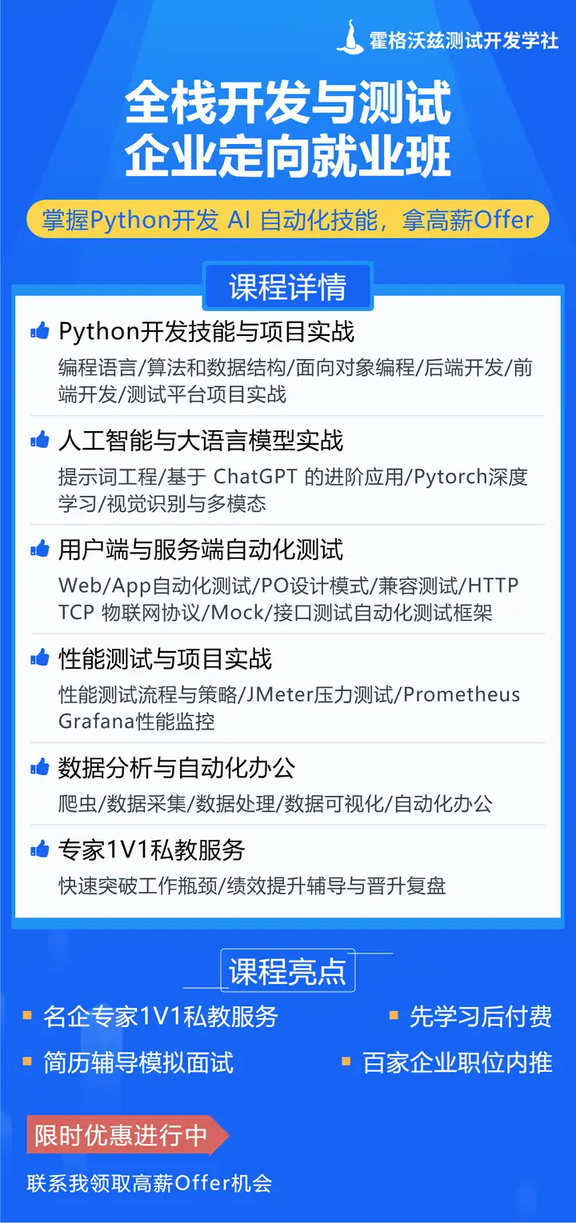引言
在 Pytest 中,Fixture 是一种非常有用的功能,它允许我们在测试前后进行一些设置和清理工作。通常,我们会在测试函数中显式地声明需要使用的 Fixture。然而,有时候我们希望某些 Fixture 在所有测试中自动应用,而不需要在每个测试函数中显式地引用。为此,Pytest 提供了autouse参数。本文将详细介绍autouse参数的用法及其最佳实践。
什么是 autouse 参数?
autouse参数是 Pytest Fixture 的一种配置选项。当autouse设置为True时,Fixture 会自动应用于所在作用范围内的所有测试,而不需要在测试函数中显式地引用它。这对于需要在许多测试中反复执行的设置或清理操作非常有用,可以简化测试代码,提高可读性。
基本用法
1. 定义一个自动应用的 Fixture
在定义 Fixture 时,通过设置autouse=True来启用自动应用:
import pytest
@pytest.fixture(autouse=True)def auto_setup_and_teardown(): print("Setup") yield print("Teardown")
复制代码
在这个示例中,auto_setup_and_teardown Fixture 会在每个测试函数前后自动执行。
2. 编写测试函数
在测试文件中编写测试函数,不需要显式地引用自动应用的 Fixture:
def test_example_1(): print("Executing test_example_1") assert True
def test_example_2(): print("Executing test_example_2") assert True
复制代码
运行测试时,输出结果将显示自动应用的 Fixture 在每个测试前后的执行情况:
输出结果:
SetupExecuting test_example_1TeardownSetupExecuting test_example_2Teardown
复制代码
高级用法
1. 作用范围
autouse参数可以与 Fixture 的作用范围结合使用,以控制 Fixture 的应用范围。以下示例展示了在不同作用范围内使用autouse参数:
@pytest.fixture(scope="module", autouse=True)def setup_module(): print("Setup module") yield print("Teardown module")
@pytest.fixture(scope="class", autouse=True)def setup_class(): print("Setup class") yield print("Teardown class")
@pytest.fixture(autouse=True)def setup_function(): print("Setup function") yield print("Teardown function")
class TestExample: def test_example_1(self): print("Executing test_example_1") assert True
def test_example_2(self): print("Executing test_example_2") assert True
复制代码
运行测试时,输出结果将显示不同作用范围的 Fixture 在适当的时机被调用:
输出结果:
Setup moduleSetup classSetup functionExecuting test_example_1Teardown functionSetup functionExecuting test_example_2Teardown functionTeardown classTeardown module
复制代码
2. 条件应用
有时候我们希望自动应用的 Fixture 只在某些特定条件下执行。可以在 Fixture 内部添加条件逻辑来实现这一点:
@pytest.fixture(autouse=True)def conditional_setup_and_teardown(request): if "skip_setup" not in request.keywords: print("Setup") yield print("Teardown") else: yield
复制代码
在测试函数中使用pytest.mark来控制 Fixture 的应用:
import pytest
@pytest.mark.skip_setupdef test_example_1(): print("Executing test_example_1") assert True
def test_example_2(): print("Executing test_example_2") assert True
复制代码
运行测试时,输出结果将显示条件应用的 Fixture 在特定测试中的执行情况:
输出结果:
Executing test_example_1SetupExecuting test_example_2Teardown
复制代码
Best Practices
适当使用 autouse:虽然autouse可以简化测试代码,但应谨慎使用,避免在每个测试中都执行不必要的操作,导致测试运行时间增加。
明确作用范围:结合 Fixture 的作用范围(scope),确保自动应用的 Fixture 在适当的范围内执行,以优化资源管理和性能。
条件应用:在需要时,通过条件逻辑控制自动应用的 Fixture,以实现更灵活的测试配置。
文档化:为自动应用的 Fixture 添加文档字符串,解释其功能和使用场景,便于团队成员理解和使用。
总结
autouse参数是 Pytest 提供的一个强大功能,可以简化测试代码的编写和管理,通过自动应用 Fixture,在测试前后进行设置和清理操作。理解并掌握autouse参数的用法,有助于编写高效、简洁的测试代码。希望本文的介绍和示例能够帮助你在实际项目中更好地应用 Pytest 的autouse参数,实现高质量的测试管理。









评论